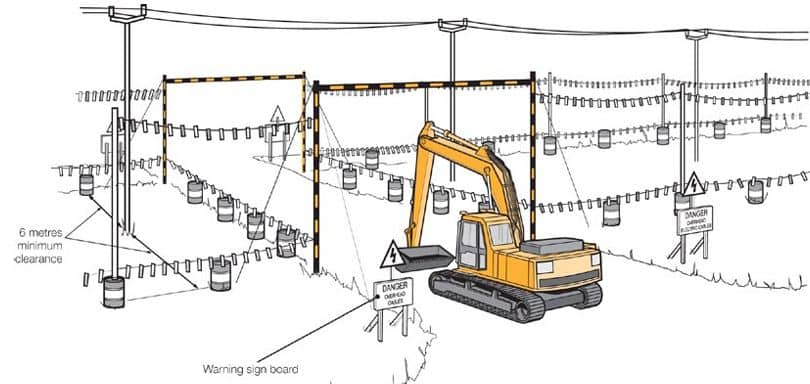Overhead Power Lines (OHPL)
Accidental contact with live overhead power lines kills people and causes many serious injuries every year. People are also harmed when a person, or object, gets too close to a line and a flashover occurs.
Work involving high vehicles, or long equipment, is particularly high risk. Examples of these include:
- Lorry mounted cranes (such as Hiabs or Palingers)
- Mobile Elevated Working Platforms (MEWP’s)
- Scaffold poles
- Tipper vehicles
- Cranes
- Ladders
Important To Remember When Working Near Overhead Power Lines
- A Risk Assessment should be conducted
- Consult Overhead Power Line owners for minimum distances, or appropriate industry guidance
- Getting close to a live Overhead Power Line can result in a flashover that may kill
- It is not just physical contact with an Overhead Power Line that causes damage
- Even voltages lower than 230 volts can kill and injure people
- Do not mistake overhead power lines on wooden poles for telephone wires
- Electricity can bypass wood, plastic, or rubber, if it is damp or dirty, and cause fatal shocks
- Don’t rely on gloves or rubber boots to protect you
- Contact with an overhead power line may cause the power to ‘trip out’ temporarily, and it may be re-energised automatically, without warning

Marshalling Near OHPLs
Traffic Marshals should only undertake marshalling near OHPLs if competent and authorised to do so, and this will normally involve:
- Managing the risk of electrocution or collision
- Establishing an Exclusion Zone (signs and barriers may be needed for this)
- Dynamic Risk Assessment
What To Do If A Vehicle Operator Comes Into Contact With An OHPL
- The driver should remain in the cab and inform the Distribution Network Operator (DNO) immediately
- Stick the number in a visible place in the vehicle cab and keep it on your mobile phone
- The responsible person / Marshal should warn others to stay away
- The vehicle operator should try to drive clear
- If this is not possible, and you need to leave the vehicle to escape fire, JUMP CLEAR – do not dismount by climbing down the steps
- Never try to disentangle or touch vehicles / equipment until the owner of the line has confirmed that it has been de-energised and made safe
The clip below shows the danger of coming into contact with OHPLs:
